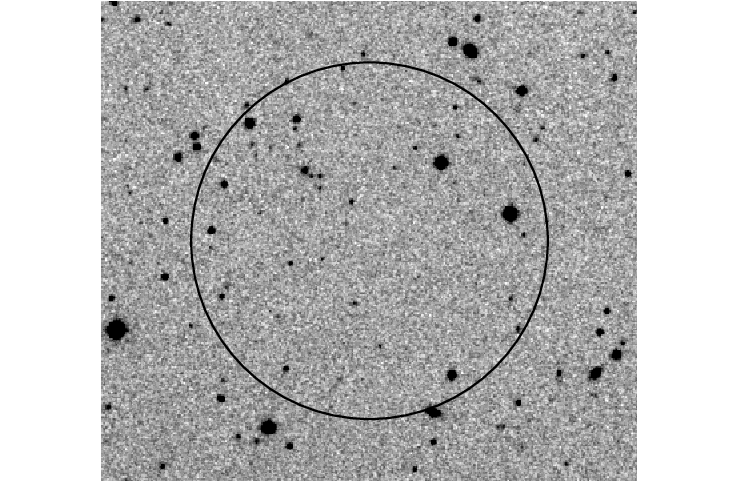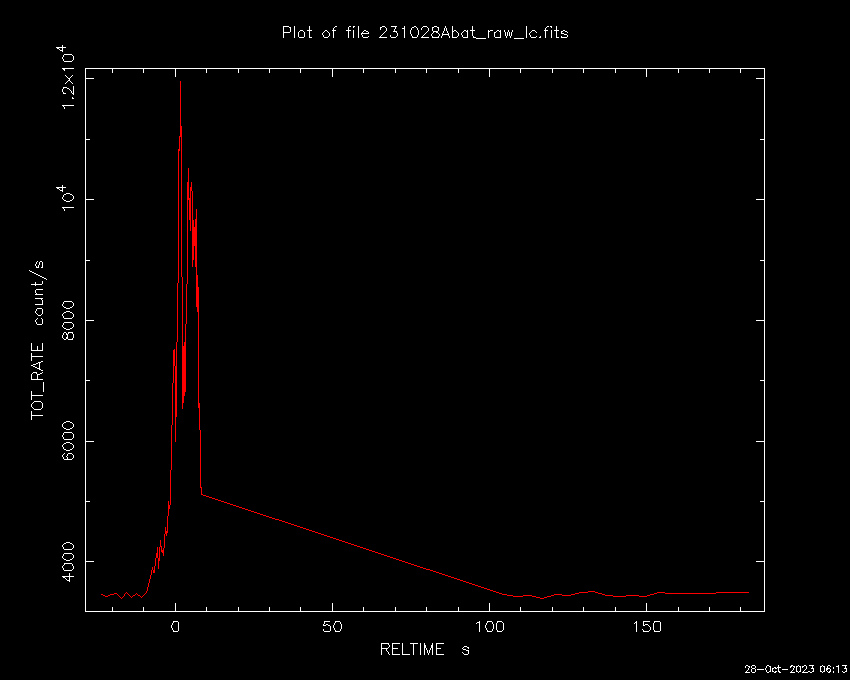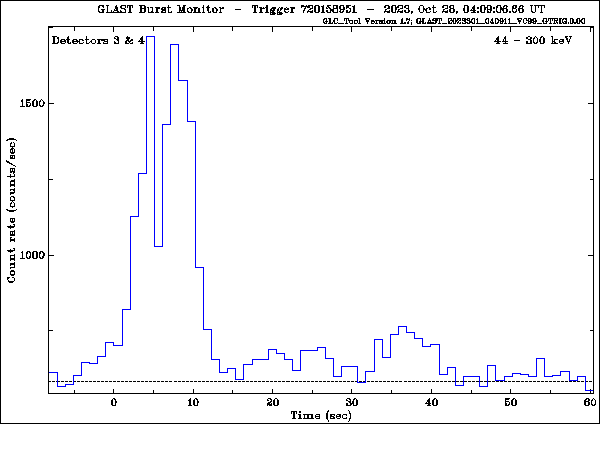(All information courtesy of the instrument teams.)
![]() Previous IAU Circulars
Previous IAU Circulars
TITLE: GCN/SWIFT NOTICE
NOTICE_DATE: Sat 28 Oct 23 04:09:23 UT
NOTICE_TYPE: Swift-BAT GRB Position
TRIGGER_NUM: 1193078, Seg_Num: 0
GRB_RA: 214.029d {+14h 16m 07s} (J2000),
214.305d {+14h 17m 13s} (current),
213.447d {+14h 13m 47s} (1950)
GRB_DEC: +20.895d {+20d 53' 42"} (J2000),
+20.785d {+20d 47' 07"} (current),
+21.127d {+21d 07' 36"} (1950)
GRB_ERROR: 3.00 [arcmin radius, statistical only]
GRB_INTEN: 4666 [cnts] Image_Peak=587 [image_cnts]
TRIGGER_DUR: 1.024 [sec]
TRIGGER_INDEX: 148 E_range: 25-100 keV
BKG_INTEN: 14502 [cnts]
BKG_TIME: 14935.73 SOD {04:08:55.73} UT
BKG_DUR: 8 [sec]
GRB_DATE: 20245 TJD; 301 DOY; 23/10/28
GRB_TIME: 14949.55 SOD {04:09:09.55} UT
GRB_PHI: -118.54 [deg]
GRB_THETA: 26.69 [deg]
SOLN_STATUS: 0x20000003
RATE_SIGNIF: 63.84 [sigma]
IMAGE_SIGNIF: 18.14 [sigma]
MERIT_PARAMS: +1 +0 +0 +0 +2 +5 -100 +0 -82 +0
SUN_POSTN: 212.21d {+14h 08m 51s} -13.01d {-13d 00' 39"}
SUN_DIST: 33.86 [deg] Sun_angle= -0.1 [hr] (East of Sun)
MOON_POSTN: 23.52d {+01h 34m 05s} +9.95d {+09d 57' 17"}
MOON_DIST: 147.48 [deg]
MOON_ILLUM: 99 [%]
GAL_COORDS: 19.62, 69.72 [deg] galactic lon,lat of the burst (or transient)
ECL_COORDS: 203.57, 32.36 [deg] ecliptic lon,lat of the burst (or transient)
COMMENTS: SWIFT-BAT GRB Coordinates.
COMMENTS: This is a rate trigger.
COMMENTS: A point_source was found.
COMMENTS: This does not match any source in the on-board catalog.
COMMENTS: This does not match any source in the ground catalog.
COMMENTS: This is a GRB.
COMMENTS: This trigger occurred at longitude,latitude = 93.46,10.45 [deg].
COMMENTS:
COMMENTS: NOTE: This BAT event is temporally(3.0<100sec) coincident with the FERMI_GBM event (trignum=720158951).

TITLE: GCN/SWIFT NOTICE
NOTICE_DATE: Sat 28 Oct 23 04:13:03 UT
NOTICE_TYPE: Swift-BAT GRB Lightcurve
TRIGGER_NUM: 1193078, Seg_Num: 0
GRB_RA: 214.029d {+14h 16m 07s} (J2000),
214.305d {+14h 17m 13s} (current),
213.447d {+14h 13m 47s} (1950)
GRB_DEC: +20.895d {+20d 53' 42"} (J2000),
+20.785d {+20d 47' 07"} (current),
+21.127d {+21d 07' 36"} (1950)
GRB_DATE: 20245 TJD; 301 DOY; 23/10/28
GRB_TIME: 14949.55 SOD {04:09:09.55} UT
TRIGGER_INDEX: 148
GRB_PHI: -118.54 [deg]
GRB_THETA: 26.69 [deg]
DELTA_TIME: 58.00 [sec]
TRIGGER_DUR: 1.024 [sec]
SOLN_STATUS: 0x3
RATE_SIGNIF: 63.84 [sigma]
IMAGE_SIGNIF: 18.14 [sigma]
LC_URL: sw01193078000msb.lc
SUN_POSTN: 212.22d {+14h 08m 52s} -13.01d {-13d 00' 43"}
SUN_DIST: 33.86 [deg] Sun_angle= -0.1 [hr] (East of Sun)
MOON_POSTN: 23.55d {+01h 34m 13s} +9.97d {+09d 58' 16"}
MOON_DIST: 147.48 [deg]
MOON_ILLUM: 99 [%]
GAL_COORDS: 19.62, 69.72 [deg] galactic lon,lat of the burst (or transient)
ECL_COORDS: 203.57, 32.36 [deg] ecliptic lon,lat of the burst (or transient)
COMMENTS: SWIFT-BAT GRB Lightcurve.
COMMENTS:
COMMENTS: The next comments were copied from the BAT_POS Notice:
COMMENTS: This is a rate trigger.
COMMENTS: A point_source was found.
COMMENTS: This does not match any source in the on-board catalog.
COMMENTS: This does not match any source in the ground catalog.
COMMENTS: This is a GRB.
COMMENTS: This trigger occurred at longitude,latitude = 93.46,10.45 [deg].
COMMENTS: The 2nd packet (of 3) was missing in the lightcurve data stream.

TITLE: GCN/FERMI NOTICE
NOTICE_DATE: Sat 28 Oct 23 04:09:45 UT
NOTICE_TYPE: Fermi-GBM Flight Position
RECORD_NUM: 59
TRIGGER_NUM: 720158951
GRB_RA: 219.583d {+14h 38m 20s} (J2000),
219.836d {+14h 39m 21s} (current),
219.053d {+14h 36m 13s} (1950)
GRB_DEC: +31.833d {+31d 49' 60"} (J2000),
+31.731d {+31d 43' 53"} (current),
+32.049d {+32d 02' 55"} (1950)
GRB_ERROR: 5.33 [deg radius, statistical plus systematic]
GRB_INTEN: 670 [cnts/sec]
DATA_SIGNIF: 67.30 [sigma]
INTEG_TIME: 4.096 [sec]
GRB_DATE: 20245 TJD; 301 DOY; 23/10/28
GRB_TIME: 14946.66 SOD {04:09:06.66} UT
GRB_PHI: 300.00 [deg]
GRB_THETA: 15.00 [deg]
DATA_TIME_SCALE: 4.0960 [sec]
HARD_RATIO: 0.90
LOC_ALGORITHM: 3 (version number of)
MOST_LIKELY: 97% GRB
2nd_MOST_LIKELY: 1% Generic Transient
DETECTORS: 1,0,0, 1,1,0, 0,0,0, 0,0,0, 0,0,
SUN_POSTN: 212.21d {+14h 08m 51s} -13.01d {-13d 00' 40"}
SUN_DIST: 45.34 [deg] Sun_angle= -0.5 [hr] (East of Sun)
MOON_POSTN: 23.52d {+01h 34m 05s} +9.96d {+09d 57' 23"}
MOON_DIST: 135.48 [deg]
MOON_ILLUM: 99 [%]
GAL_COORDS: 50.83, 66.33 [deg] galactic lon,lat of the burst (or transient)
ECL_COORDS: 203.66, 44.37 [deg] ecliptic lon,lat of the burst (or transient)
LC_URL: http://heasarc.gsfc.nasa.gov/FTP/fermi/data/gbm/triggers/2023/bn231028173/quicklook/glg_lc_medres34_bn231028173.gif
COMMENTS: Fermi-GBM Flight-calculated Coordinates.
COMMENTS: This trigger occurred at longitude,latitude = 118.10,-13.27 [deg].
COMMENTS: The LC_URL file will not be created until ~15 min after the trigger.
COMMENTS:
COMMENTS: NOTE: This GBM event is temporally(2.0<100sec) coincident with the CALET_GBM event (trignum=1382501309).
TITLE: GCN/FERMI NOTICE
NOTICE_DATE: Sat 28 Oct 23 04:09:38 UT
NOTICE_TYPE: Fermi-GBM Flight Position
RECORD_NUM: 45
TRIGGER_NUM: 720158951
GRB_RA: 221.033d {+14h 44m 08s} (J2000),
221.294d {+14h 45m 11s} (current),
220.486d {+14h 41m 57s} (1950)
GRB_DEC: +26.950d {+26d 56' 60"} (J2000),
+26.850d {+26d 51' 01"} (current),
+27.161d {+27d 09' 39"} (1950)
GRB_ERROR: 26.48 [deg radius, statistical plus systematic]
GRB_INTEN: 66 [cnts/sec]
DATA_SIGNIF: 5.50 [sigma]
INTEG_TIME: 2.048 [sec]
GRB_DATE: 20245 TJD; 301 DOY; 23/10/28
GRB_TIME: 14946.66 SOD {04:09:06.66} UT
GRB_PHI: 320.00 [deg]
GRB_THETA: 15.00 [deg]
DATA_TIME_SCALE: 2.0480 [sec]
HARD_RATIO: 0.00
LOC_ALGORITHM: 3 (version number of)
MOST_LIKELY: 100% Unreliable location
2nd_MOST_LIKELY: 0% n/a
DETECTORS: 1,0,0, 1,1,0, 0,0,0, 0,0,0, 0,0,
SUN_POSTN: 212.21d {+14h 08m 51s} -13.01d {-13d 00' 40"}
SUN_DIST: 40.83 [deg] Sun_angle= -0.6 [hr] (East of Sun)
MOON_POSTN: 23.52d {+01h 34m 05s} +9.96d {+09d 57' 21"}
MOON_DIST: 139.35 [deg]
MOON_ILLUM: 99 [%]
GAL_COORDS: 39.04, 64.96 [deg] galactic lon,lat of the burst (or transient)
ECL_COORDS: 207.94, 40.44 [deg] ecliptic lon,lat of the burst (or transient)
LC_URL: http://heasarc.gsfc.nasa.gov/FTP/fermi/data/gbm/triggers/2023/bn231028173/quicklook/glg_lc_medres34_bn231028173.gif
COMMENTS: Fermi-GBM Flight-calculated Coordinates.
COMMENTS: This trigger occurred at longitude,latitude = 118.10,-13.27 [deg].
COMMENTS: The LC_URL file will not be created until ~15 min after the trigger.
COMMENTS:
COMMENTS: NOTE: This GBM event is temporally(3.0<100sec) coincident with the SWIFT_BAT event (trignum=1193078).
TITLE: GCN/FERMI NOTICE
NOTICE_DATE: Sat 28 Oct 23 04:09:54 UT
NOTICE_TYPE: Fermi-GBM Ground Position
RECORD_NUM: 58
TRIGGER_NUM: 720158951
GRB_RA: 214.780d {+14h 19m 07s} (J2000),
215.053d {+14h 20m 13s} (current),
214.207d {+14h 16m 50s} (1950)
GRB_DEC: +23.000d {+23d 00' 00"} (J2000),
+22.891d {+22d 53' 29"} (current),
+23.229d {+23d 13' 46"} (1950)
GRB_ERROR: 2.08 [deg radius, statistical only]
DATA_SIGNIF: 51.70 [sigma]
DATA_INTERVAL: 2.048 [sec]
GRB_DATE: 20245 TJD; 301 DOY; 23/10/28
GRB_TIME: 14946.66 SOD {04:09:06.66} UT
GRB_PHI: 322.00 [deg]
GRB_THETA: 22.00 [deg]
E_RANGE: 44.032 - 279.965 [keV]
LOC_ALGORITHM: 4173 (Gnd S/W Version number)
SUN_POSTN: 212.21d {+14h 08m 51s} -13.01d {-13d 00' 40"}
SUN_DIST: 36.01 [deg] Sun_angle= -0.2 [hr] (East of Sun)
MOON_POSTN: 23.52d {+01h 34m 06s} +9.96d {+09d 57' 25"}
MOON_DIST: 145.27 [deg]
MOON_ILLUM: 99 [%]
GAL_COORDS: 26.02, 69.75 [deg] galactic lon,lat of the burst (or transient)
ECL_COORDS: 203.35, 34.57 [deg] ecliptic lon,lat of the burst (or transient)
LC_URL: http://heasarc.gsfc.nasa.gov/FTP/fermi/data/gbm/triggers/2023/bn231028173/quicklook/glg_lc_medres34_bn231028173.gif
POS_MAP_URL: http://gcn.gsfc.nasa.gov/notices_f/gbm_gnd_loc_map_720158951.fits
COMMENTS: Fermi-GBM Ground-calculated Coordinates.
COMMENTS: In the LAT Field-of-view.
COMMENTS: This Notice was ground-generated -- not flight-generated.
COMMENTS: The LC_URL file will not be created/available until ~15 min after the trigger.
COMMENTS: The POS_MAP_URL file will not be created/available until ~1.5 min after the notice.
COMMENTS:
COMMENTS: NOTE: This GBM event is temporally(2.0<100sec) coincident with the CALET_GBM event (trignum=1382501309).
TITLE: GCN/FERMI NOTICE
NOTICE_DATE: Sat 28 Oct 23 04:18:23 UT
NOTICE_TYPE: Fermi-GBM Final Position
RECORD_NUM: 0
TRIGGER_NUM: 720158951
GRB_RA: 214.300d {+14h 17m 12s} (J2000),
214.575d {+14h 18m 18s} (current),
213.722d {+14h 14m 53s} (1950)
GRB_DEC: +21.820d {+21d 49' 12"} (J2000),
+21.711d {+21d 42' 38"} (current),
+22.051d {+22d 03' 03"} (1950)
GRB_ERROR: 1.00 [deg radius, statistical only]
GRB_DATE: 20245 TJD; 301 DOY; 23/10/28
GRB_TIME: 14946.66 SOD {04:09:06.66} UT
GRB_PHI: 324.00 [deg]
GRB_THETA: 23.00 [deg]
E_RANGE: 44.032 - 279.965 [keV]
LOC_ALGORITHM: 41731 (Gnd S/W Version number)
SUN_POSTN: 212.22d {+14h 08m 53s} -13.01d {-13d 00' 47"}
SUN_DIST: 34.80 [deg] Sun_angle= -0.2 [hr] (East of Sun)
MOON_POSTN: 23.60d {+01h 34m 24s} +10.00d {+09d 59' 42"}
MOON_DIST: 146.51 [deg]
MOON_ILLUM: 99 [%]
GAL_COORDS: 22.38, 69.81 [deg] galactic lon,lat of the burst (or transient)
ECL_COORDS: 203.42, 33.31 [deg] ecliptic lon,lat of the burst (or transient)
LC_URL: http://heasarc.gsfc.nasa.gov/FTP/fermi/data/gbm/triggers/2023/bn231028173/quicklook/glg_lc_medres34_bn231028173.gif
LOC_URL: http://heasarc.gsfc.nasa.gov/FTP/fermi/data/gbm/triggers/2023/bn231028173/quicklook/glg_locplot_all_bn231028173.png
COMMENTS: Fermi-GBM Final Position.
COMMENTS: This Notice was ground-generated -- not flight-generated.
COMMENTS: The LC_URL file should be available by the time this FINAL notice is produced.
COMMENTS: This notice was generated completely by automated pipeline processing.
COMMENTS: In the LAT Field-of-view.
COMMENTS: This is likely a Long GRB.
COMMENTS:
COMMENTS: NOTE: This GBM event is temporally(2.0<100sec) coincident with the CALET_GBM event (trignum=1382501309).

RA(J2000) = 14h 16m 07s Dec(J2000) = +20d 53' 42"with an uncertainty of 3 arcmin (radius, 90% containment, including systematic uncertainty). The BAT light curve showed a complex peak structure with a duration of at least 18 sec, although the immediately available data is truncated at T+8s due to packet loss. The peak count rate was ~8500 counts/sec (15-350 keV), at ~1 sec after the trigger.
1) The Swift_BAT_Position notice did not indicate a LoL. (See the comments section.) 2) This burst location was not near to a known bright source. 3) There was a simultaneous trigger by Fermi-GBM. 4) This is a rate-triggered burst on a 1.024 s timescale, while most LoL false triggers have been 'Image Triggers' with duration 64 s and longer.Observers should continue to be cautious (especially checking the comments for LoL) in future GCN notices going forward.
Tmid-T0 | Site |Filt.| Expt. | Limit| Comment _________|_____________________|_____|_______|______|________ 39937 | MASTER-Kislovodsk | C | 180 | 13.6 | 40139 | MASTER-Kislovodsk | C | 180 | 13.0 | 40340 | MASTER-Kislovodsk | C | 180 | 14.5 | 41732 | MASTER-Kislovodsk | C | 180 | 13.0 | 65699 | MASTER-Tunka | C | 60 | 16.0 |Filter C is a clear (unfiltred) band.
[1] Grove, J.E. et al. 2020, Proc. Yamada Conf. LXXI, arXiv:2009.11959 [2] Woolf, R.S. et al. 2022, Proc. SPIE, 12181, id. 121811O [3] Goldstein, A. et al. 2020, ApJ 895, 40, arXiv :1909.03006Distribution Statement A: Approved for public release. Distribution is unlimited.
RA(J2000) = 14h 16m 03.8s Dec(J2000) = +20d 53' 47.8"with an uncertainty of 1.0 arcmin, (radius, sys+stat, 90% containment). The partial coding was 68%.